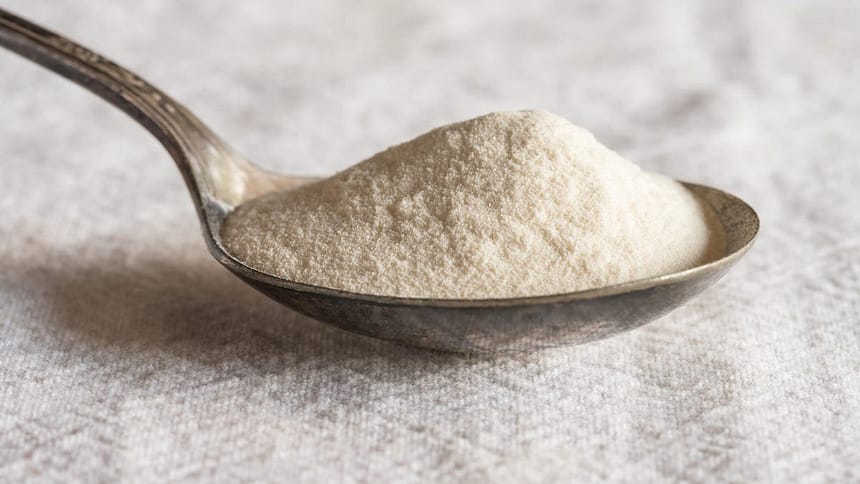With people becoming increasingly conscious about their health, more attention is given to food labels and ingredient lists, especially additives. Xanthan gum is one such additive found in many foods, from salad dressings to gluten-free baked goods. It’s even found in personal care, industrial and pharmaceutical products.
Research suggests that xanthan gum can lead to several health benefits, such as relieving constipation, lowering blood glucose levels and cholesterol and improving gut health. However, it can cause stomach discomfort and other side effects in some people. That raises the question: should you be concerned about consuming xanthan gum? This article explores what xanthan gum is, its potential benefits and adverse effects and whether or not you should avoid it.
What is xanthan gum?
Xanthan gum is a common additive that helps thicken and stabilize various products. It’s made by fermenting sugar with the bacterium Xanthomonas campestris. It’s also a soluble fiber because it can dissolve in water, forming a gel-like substance in your digestive system.
“This means that our body could not digest xanthan gum, so it was of no nutritional value to us. But recent work has shown that humans can host bacteria (Ruminococcaceae) in our gut microbiome that can break down xanthan,” says Eric Johnson, senior biology lecturer at Johns Hopkins University. While the human gut can absorb the byproducts of Ruminococcaceae during digestion, they’re also readily used by Bacteroides, a much more common group in the human gut microbiome. However, Johnson adds that further research is necessary to understand the nutritional impact of xanthan gum.
Xanthan gum was first discovered in 1960 and approved by the US Food and Drug Administration (FDA) in 1968 for use in food and pharmaceutical products. It’s considered a sustainable alternative to gums such as guar gum, gum arabic, alginate and pectin. Unlike these gums, xanthan gum doesn’t rely on specific climatic conditions for production, nor does it harm the ecosystem. Its high solubility, viscosity and thermal stability make it a reliable choice for a wide range of uses.
What is xanthan gum in?
Xanthan gum is used in a wide range of food, personal care, industrial and pharmaceutical products.
Food products
Xanthan gum in food products helps create a softer mouthfeel, making consumers feel the food tastes better. It also enhances texture while maintaining consistency and moisture. Baked goods with xanthan gum often have fewer calories and less gluten.
A few common foods containing xanthan gum include:
- Salad dressings
- Soups and sausages
- Baked goods such as biscuits and cakes
- Processed meats
- Gravies
- Ice cream and milkshakes
- Fruit-based drinks/smoothies (not 100% fruit juice)
Personal care products
The presence of xanthan gum helps improve personal care products’ stability and texture and prevents ingredient separation. Everyday products containing xanthan gum include:
- Toothpaste
- Shampoo
- Creams
- Lotions
Industrial products
Xanthan gum in industrial products improves their stability, promotes better mixing and maintains a stable pH. Standard industrial products with xanthan gum include:
- Polishes
- Cleansers
- Aqueous paints
- Glues
- Textile and flooring print
Pharmaceutical products
“Beyond food, xanthan gum is also found in pharmaceuticals such as liquid antibiotics (i.e., amoxicillin suspensions), cough syrups and topical formulations like hydrocortisone cream — along with various cosmetics,” says Thomas Holland, a physician-researcher and associate professor at Rush University.
Xanthan gum also aids in drug delivery by enabling slow, controlled release and enhancing stability. It’s commonly used in brain and nasal delivery, topical treatments and both solid and liquid oral medications.
Potential health benefits of xanthan gum
“While some food additives only benefit the food product, xanthan gum also has potential health benefits since it is a soluble fiber. Studies show taking xanthan gum can decrease constipation, and it is used as a thickener to reduce the risk of aspiration in people with swallowing dysfunction,” says Caroline Passerrello, instructor and community coordinator at the Department of Sports Medicine and Nutrition, University of Pittsburgh. Studies show that consistent use of xanthan gum may lower blood glucose in people with diabetes, but she adds that more research is needed to support this recommendation.
Xanthan gum may contribute to gut health by acting as a prebiotic (setting up the environment for the growth of a good gut microbiome). Some studies suggest it could promote satiety and slow glucose absorption, helping reduce hunger and prevent blood sugar spikes, says Holland.
Research also suggests xanthan gum may be capable of lowering cholesterol. A 1986 study found that men who consumed xanthan gum at 15 times the acceptable daily intake for 23 days saw a 10% drop in cholesterol levels. Amelia Ti, a registered dietitian and diabetes educator in New York City, who is also a member of CNET’s medical review board, notes, “The amount they consumed in this study is not advisable or realistic. Also, newer studies have not confirmed these benefits at regular consumption levels.”
Xanthan gum’s potential negative side effects
“At typical food levels, xanthan gum is generally safe. However, excessive intake, which would be considered over 15 grams per day, can potentially lead to gastrointestinal discomfort, including bloating, gas, abdominal pain and diarrhea, due to its fiber content,” says Holland.
Thus, individuals with sensitivities to fermented products or pre-existing digestive conditions like IBS (irritable bowel syndrome) or IBD (inflammatory bowel disease) may experience mild intolerance, he notes.
Plus, you may also want to avoid inhaling xanthan gum as it can lead to unwanted side effects. A 1990 study indicated that workers handling xanthan gum powder experienced flu-like symptoms with nose and throat irritation.
Is xanthan gum safe?
Xanthan gum is generally recognized as safe (GRAS) by the FDA. “This means that it is GRAS when used orally or medicinally up to 15 grams per day,” says Passerrello. “To put that into perspective, there is usually about 0.05 to 0.25 grams of xanthan gum in a two tablespoons of salad dressing. To reach the GRAS amount per day, someone would need to eat between 60-300 servings of salad dressing a day.”
However, Melanie Murphy Richter, a registered dietitian nutritionist and instructor of Nutrition Physiology at the University of California, says it is safe for many but not beneficial for all.
“In functional nutrition, we don’t label foods as ‘good’ or ‘bad’ across the board — we look at how they interact with your biology. If you have digestive concerns, a sensitive gut or you’re healing from food sensitivities, it might be worth experimenting with a gum-free period to see how your body responds,” she adds.
Who should avoid xanthan gum?
Although xanthan gum is generally safe for everyone, some people may need to limit or avoid it. Individuals with gastrointestinal conditions such as IBS or IBD (such as Crohn’s or ulcerative colitis) may need to limit their intake to avoid digestive issues or discomfort, says Holland.
Additionally, those with severe corn, soy or wheat allergies should check food labels. Holland adds that xanthan gum is often derived from these ingredients.
A 2012 study also suggests that xanthan gum used in thickened infant formulas may lead to serious digestion problems, including necrotizing enterocolitis (NEC) in premature infants.
Also, individuals on diabetes medications must consult with their doctor before taking xanthan gum. This is because xanthan gum can lower blood glucose levels, which may interfere with ongoing medications.
Xanthan gum substitutes in recipes
“I generally don’t recommend people include or avoid specific ingredients, but rather to consider their overall food choices and meal patterns,” says Passerrello. “If someone is looking to add soluble fiber to their diet, xanthan gum may be one option, but it is not the only source of soluble fiber available. If someone has identified xanthan gum as the definite cause for their GI distress, I’d recommend limiting their intake and looking for products where xanthan gum is not on the ingredient list or is listed toward the end.”
For those with sensitivities to xanthan gum or specific dietary needs, using substitutes may be a better option to avoid potential adverse effects. Alternatives like psyllium husk, chia seeds, agar-agar or gelatin can provide similar thickening properties without the potential digestive side effects. Some substitutes, such as psyllium husk, offer additional health benefits, like a higher fiber content that can improve digestion, says Holland.
Again, the best substitute choice depends on the intended use (e.g., baking versus sauces) and an individual’s dietary restrictions, he adds.
The bottom line
Xanthan gum is a common thickening and stabilizing agent found in food, personal care, industrial and even pharmaceutical products. Xanthan gum has several potential benefits, including improving constipation, lowering blood glucose levels and lowering aspiration risk in people with swallowing problems. However, it may not be suitable for everyone. It’s best to consult your doctor, especially if you’re experiencing stomach discomfort after taking xanthan gum or if you have a medical condition such as diabetes.





